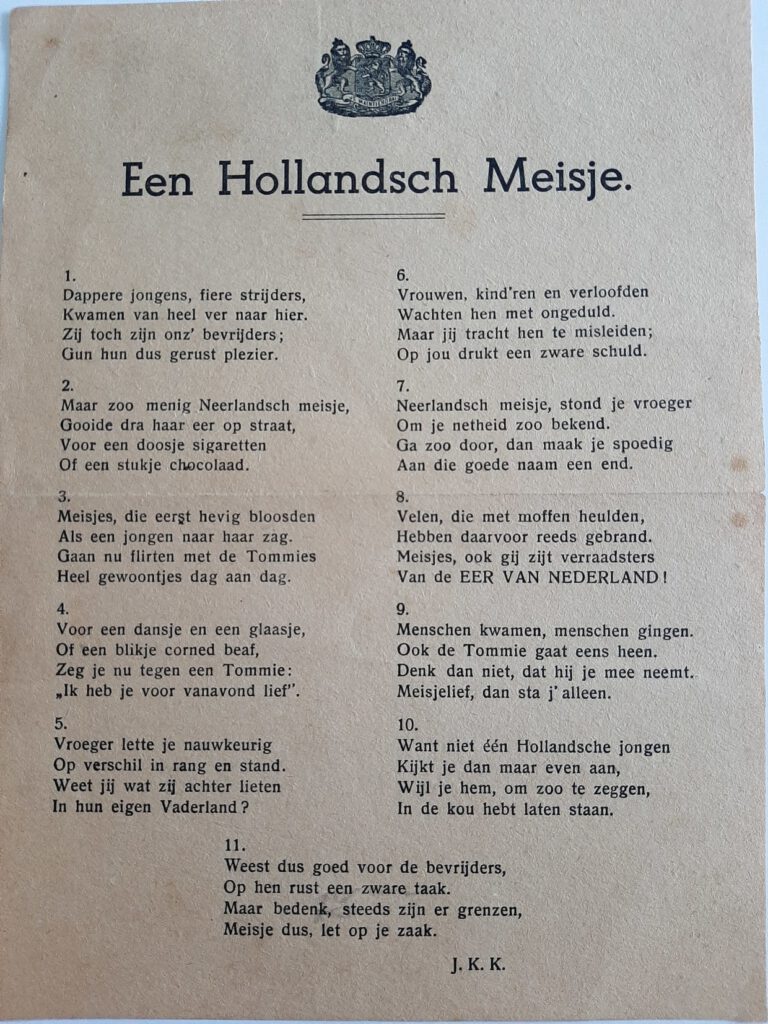Liberation
Loose morals or
a prudish society?
While the Dutch will always be grateful to the Allied soldiers for the liberation, there also was a moment shortly after the liberation when some people were desperate to get rid of these young men. When the Netherlands was liberated, many Allied soldiers could not immediately return home. The soldiers, especially Canadians, had to remain in leave camps for quite some time. Activities were planned to entertain the men while they resided in these camps. At first, in the fall of 1944 when only the South was liberated, these activities were regulated. Church committees would for instance organize dance nights where Dutch girls were invited to entertain the liberators. Catholic newspaper De Gelderlander wrote that girls saw these dance evenings as a duty to the country and to the liberators. Their behavior was exemplary.
Romance
When the rest of the Netherlands was liberated on May 5th, 1945, there was a lot of excitement. The liberators, young men in uniform, drove through the cities in their jeeps. Thousands of people were in the streets, waving and cheering them on. Some of the people, especially young girls, rode along on the jeeps. De Gelderlander mentioned that these girls were attracted to the Canadians because their “uniform works like a magnet and the unfamiliarity works like a charm. The tension of the war years and the appreciation for the liberators does the rest.” The events to entertain the soldiers spread over the country, but not as regulated as at the start. Soldiers were invited to all kinds of events, like dance evenings and cinema visits. Dutch girls stood in line for the opportunity to join the soldiers, as they were allowed to bring a guest. Vrij Nederland suggests that this deliberately influenced the dignity of Dutch girls, as it was only logical that girls would want these opportunities after the war years.
Romantic relations between Dutch girls and Allied soldiers, and events leading up to these meetings were not perceived very positively by most media during and after the liberation. Christian news outlets were especially harsh in their tone about the behavior of young Dutch women. According to many of these sources, these girls had lost their morals. Some sources blamed the Allied soldiers for having the girls under some kind of spell. They wrote that even the most well-behaved girls showed unrespectable behavior like getting drunk and having loose sexual morals.
Sources:
“21-Dance-club en Dance-Comite,” De Gelderlander (11 September 1945) https://studiezaal.nijmegen.nl/detail.php?nav_id=73-1&id=302030405.
“Daar komen de Canadeezen,” De Gelderlander (22 August 1945) https://studiezaal.nijmegen.nl/detail.php?nav_id=77-1&index=4&imgid=342380402&id=302030357.
Bonnie Okkema, Trees Krijgt een Canadees (Zutphen: Walburg Pers, 2012).
A Dutch Girl

Image
This poem, called “Our Dutch Girls” was spread after the war as a pamphlet to voice concern about romantic relationships between Dutch girls and Allied soldiers and the suggested moral decay of young Dutch girls. Image © Rianne Oosterom, “Een Hollandsch Meisje,” Trouw, published May 5, 2020, https://www.trouw.nl/nieuws/de-seksuele-losbandigheid-na-de-oorlog-alles-zoop-en-naaide~b52e2d7a/?referrer= https%3A%2F%2Fwww. google.com%2F.
Textual sources
“Zoeklichtjes,” Margriet: weekblad voor vrouwen en meisjes (18 May 1946).
The writer of the poem “Een Hollandsch Meisje”, which can be translated to “A Dutch Girl”, also voices their discontent regarding romantic relationships between Dutch girls and Allied soldiers. The poem, which was spread as a pamphlet, expressed disdain for the Dutch girls who had such relationships, suggesting that they threw out their morals just for a piece of chocolate or a pack of cigarettes. Additionally, it reads that girls used to know their place in society, but that they had now sold their body for attention, a date, or products. “Een Hollandsch Meisje” looks back at a time where girls were known for their neatness and respectability, which was said to change because of the presence of the Allied soldiers.
This poem shares a certain opinion with women’s magazine Margriet. It warns that the girls who had a romantic relationship with an Allied soldier would be all alone when these soldiers went back home. No Dutch guy would ever consider them because these girls had left them out in the cold. Margriet writes a similar message: they consider that it was very hard for young Dutch men to see that they were second choice after the Allied soldiers. Dutch men felt disregarded and the behavior of Dutch girls who were involved with Allied soldiers raised bitterness, hostility, and judgmental attitudes in Dutch men. According to Margriet, it would have been a “task for the girls to prevent this disregard.”
heartbroken
“Een Hollandsch Meisje” ends with a direct message to the girls, saying that they should be good to the liberators as they have had a heavy task – but that they have to realize that there are limits, so they have to behave. Of course, you have to read this poem and news sources with consideration for the time it was written in and with consideration for the Christian base many of these sources had. Naturally, not everybody had the same opinion. But some people were happy to see the Allied soldiers leave sooner rather than later after the liberation. You probably did not learn that in history class. What we are left with now is a collective memory of heroes that liberated our beautiful country, and then seemingly vanished into thin air. The only thing slightly reminiscent of these romantic involvements might be the many liberation children, the stories of our grandparents, and the memory of heartbroken Hollandsche Meisjes.